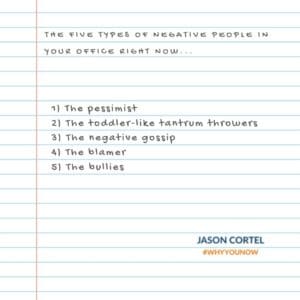There are five types of negative employees in your office or on your team right now that need coaching. They are draining to talk to, create a toxic environment, and make the change process difficult for everyone. When you see them marching toward your desk or their number appears on your phone, you cannot help but cringe because you know what is coming next. No matter how well you’ve crafted your office culture, negative people will always be there. As a result, it is vital to know how to coach the five types of negative employees in your office and your team.
Five types of toxic employees in your office right now that need coaching
- The pessimist – this type of negative employee is in a perpetual state of doom and gloom. Nothing is enough for this person. Because they continuously repeat their opinion that nothing will work, they breathe life into it, enlist others, and ultimately cause the doom and gloom to come true. The more people they get to buy into their story of a hopeless situation, the sooner you will find failure.
- The toddler-like tantrum throwers – this type of negative employee has learned from experience that if they need something done their way, they can throw a tantrum, and others will submit to their childish demands. They kick, yell, scream, throw things, and pound their hands on a table or wall. Even more, they could become violent by hitting or shoving another person.
- The negative gossip – there are varying degrees of gossip, but this type of negative employee in your office right now spreads rumors and gossip about others to cover up their insecurities. The gossiper is toxic in any group because they feed on the misfortunes and mistakes of others. Even worse, they often exaggerate the truth. When bored, they will take and pull information from any source to get attention. Power, control, jealousy, revenge, and popularity are all motivators and incentives for this type of negative person in your office.
- The blamer – you know this person well because of their victimization personality. This type of negative employee in your office takes little to no responsibility for anything. The blamer has their finger ready to point to anyone and everyone around them. They lack self-control and suffer from low self-esteem. Further, the blamer puts all of their energy into redirecting blame away from themselves.
- The bullies – these are the egotistical master manipulators who use deception to get what they want and are among the worst type of negative employees in your office right now. They will feed on those who are sensitive and kind. Even more, bullies are often quiet and hard to spot as they pass through our lives, but they have tremendous destructive powers.

What are the impacts of negativity in the workplace?
Diminished performance, low employee morale, harm to your company’s reputation, and difficulty recruiting talent are consequences of not coaching negative employees. According to the Society for Human Resource Management organizations have lost over $220 billion over the past five years because employees have left their jobs due to poor company culture. However, the intangible costs far exceed that. As a result, it is critical to coach negative employees quickly and directly.
Negative actions quickly spread from person to person and affect everyone in the organization. If you aren’t coaching the five types of negative employees in your office, they can decrease work performance by 30 percent. Additionally, if your middle managers aren’t addressing a toxic work environment, you will see an increase in absenteeism and turnover.
Furthermore, not coaching negative employees in your office will cause the following:
- Lawsuits for harassment, discrimination, or defamation
- Employees lose trust in each other
- Increased conflicts
- Employees fail to meet their responsibilities
- Lost revenue
- Missed opportunities
- Increased customer complaints or turnover
How do you coach negative employees?
Some people go to incredible lengths to be difficult. All of us have had different life experiences that have created our personalities. Coaching a negative employee is one of the most uncomfortable things to do, even for the most seasoned leaders. The process will test your communication skills because you have to decipher if the negative attitude is caused by external factors such as workload, family, co-workers, etc.
Step one of coaching negative employees – start the conversation
The objective isn’t to bring awareness to their negative attitude but instead to get them talking. Start a casual conversation by asking questions and listening carefully. When people feel heard and understood, they are less likely to deny, deflect, or make excuses. Therefore, it is important to acknowledge the negative employee’s feelings.
Step two – be objective
Once they recognize they have had a negative attitude, show them how their mood has affected others by using facts and observations. Doing so helps them see the bigger picture. Explain how their attitude is impacting their ability to contribute to their goals and objectives. The negative employee’s response to this step will highlight their level of professional maturity. It demonstrates their ability to look at their actions from another perspective. Provide them with space and patience to think, reflect, and consider the opportunity for coaching you are offering them. Stay objective when coaching negative employees.
Step three – clarify, refresh, and remind
Clarify the culture you are trying to build is critical when coaching negative employees. Refresh the negative employee on the values they should demonstrate. Remind them what they come to work to do. Everyone is expected to manage and control their frustrations and irritations. More importantly, remind them you are a resource for when things get unbearable. Everyone is required to demonstrate civility, composure, and self-awareness. Sometimes people need a little reminder.
Step four – set goals and develop a plan
To start coaching negative employees, set a realistic and specific goal for turning their attitude around. Develop a plan that maps out how they will reach it. Finally, ask for their commitment to take action.
Step five – close the coaching session with a recap of key points
Now that you’ve had a productive coaching conversation with a negative employee, tell them you appreciate their cooperation. Thank them for their ideas and for being open to your observations. Recap the conversation to ensure understanding. Finally, set a time to revisit and check on progress.
Typically, negative employees have some underlying issue. Seek to understand the root cause of their negative attitude. If you can help them rectify it, do so. On the other hand, if you can’t help them direct them to your employee assistance program. However, if they don’t take the next step to get help, you might have to say goodbye.
Follow this process to coach a negative employee. Approach the coaching conversation with an open mind and without judgment. In doing so, the negative employee will value your courage and appreciate your skills to improve their attitude. By managing their mood and emotions, they will be more successful and get more satisfaction out of coming to work.
Last updated on June 2nd, 2022 at 06:48 am


